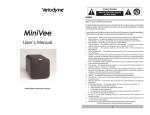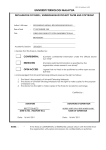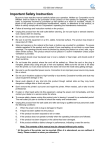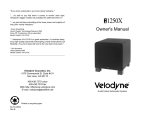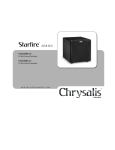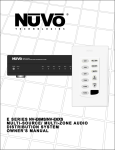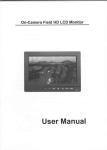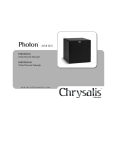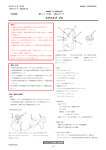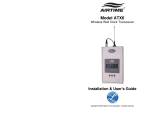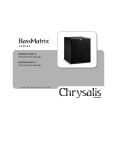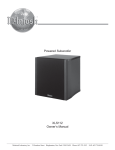Download JBL ATX100S Home Theater System User Manual
Transcript
X + 0 + Y 2 0 M HZ OWNER’S GUIDE PRODUCT LINE: ATX Series MODEL NUMBER: ATX20/30/40/60/10C/100S (230V) DESIGN GOAL: Bring the thrill of live performance and movie sound to the home environment by calling on JBL’s professional engineering leadership. PROFESSIONAL REFERENCE: Home Loudspeaker Series THANK YOU FOR CHOOSING JBL For more than 50 years, JBL has been involved in every aspect of music and film recording and reproduction, from live performances to the recordings you play in your READ THIS! CAUTION RISK OF ELECTRIC SHOCK DO NOT OPEN CAUTION: To prevent electric shock, do not remove the grounding plug on the power cord, or use any plug or extension cord that does not have a grounding plug provided. Make certain that the AC outlet is properly grounded. Do not use an adapter plug with this product. The lightning flash with arrowhead symbol, within an equilateral triangle, is intended to alert the user to the presence of uninsulated “dangerous voltage” within the product’s enclosure that may be of sufficient magnitude to constitute a risk of electric shock to persons. The exclamation point within an equilateral triangle is intended to alert the user to the presence of important operating and maintenance (servicing) instructions in the literature accompanying the appliance. General: 1. Unpacking: Check the product carefully. If it has been damaged in transit, report the damage immediately by calling your dealer and/or the shipping company that delivered it. 2. Connections: Whenever changing, connecting or disconnecting signal or power cables etc., always turn off all equipment. This prevents transients from entering the equipment and prevents electrical energy from reaching you. Keep all connections out of the reach of children. Before moving the unit, be certain to disconnect any interconnection cords with other components, and make certain that you disconnect any powered units from the AC outlet. 3. Read Instructions. All the safety and operating instructions should be read before the product is operated. 4. Retain Instructions. The safety and operating instructions should be retained for future reference. 5. Heed Warnings. All warnings on the product and in the operating instructions should be adhered to. 6. Follow Instructions. All operating and use instructions should be followed. 7. Water and Moisture. The product should not be used near water – for example, near a bathtub, washbowl, kitchen sink, laundry tub, in a wet basement, or near a swimming pool, and the like. 2 home, car or office. We’re confident that the JBL system you have chosen will provide every note of enjoyment that you expected – and that when you think about purchasing addi- tional audio equipment for your home, car or office, you will once again choose JBL. JBL Consumer Products Important Safety Precautions! 8. Accessories. To ensure proper operation and to avoid the potential for safety hazards, place the unit on a firm and level surface. When placing the unit on a shelf, be certain that the shelf and any mounting hardware can support the product’s weight. Do not place this product on an unstable cart, stand, tripod, bracket, or table. The product may fall, causing serious injury to a child or adult, and serious damage to the product. Use only with a cart, stand, tripod, bracket, or table recommended by the manufacturer, or sold with the product. Any mounting of the product should follow the manufacturer’s instructions, and should use a mounting accessory recommended by the manufacturer. 9. Wall or Ceiling Mounting. The product should be mounted on a wall or ceiling only when and as recommended by the manufacturer. 10. Cleaning. Unplug this product from the wall outlet before cleaning. Do not use liquid cleaners or aerosol cleaners. Use a damp cloth for cleaning. 11. Attachments. Do not use attachments not recommended by the product manufacturer, as they may cause hazards. 12. Replacement Parts. When replacement parts are required, be sure the service technician has used replacement parts specified by the manufacturer or that have the same characteristics as the original part. Unauthorized substitutions may result in fire, electric shock or other hazards. 13. Safety Check. Upon completion of any service or repairs to this product, ask the service technician to perform safety checks to determine that the product is in proper operating condition. 14. Feet/Spikes. When positioning, or moving this product ensure that is lifted rather than dragged across any floor/mounting surface. This will avoid any damage to the floor/mounting surface. Attention! Products and/or product feet constructed of rubber or plastics may, in seldom cases, react chemically and discolor treated or non-treated wooden surfaces if positioned without protection. 15. Warranty: The following conditions may result in a void product warranty: a. the manufacturers serial number is removed or forged. b. if repairs and/or modifications and/or other treatments/tunings have been carried out by non-authorized personnel or accessories/supplements are attached, which are not approved by manufacturer/importer. 16. Warranty: The following items are not covered by the product warranty: a. Damage caused by inappropriate handling despite clear instructions provided in the owners manual. b. Damage to mechanical parts (such as record-/playback heads, moving rubber and plastic parts and fuses) as well as results of normal wear and tear. c. Damage caused by external action or influence. d. Damage caused by miss-use by user. e. Damage caused by excessive electrical mains supply voltage or lightning strike. f. Damage caused by fire, water or smoke. g. Damage known to buyer prior to purchase. h. Damage caused by professional employment of home entertainment products (e.g. for catering trade, restaurants, public address or infinite loop announcement use etc.) 17. Specifications: All product specifications/features are subject to change without notification. Passive Products: 18. Amplifiers: Amplifiers used to drive these units must deliver a sufficient output power. A lack of output power may lead to amplifier-clipping, which causes damage not covered by guarantee. Active (Powered) Products: 19. Ventilation. Slots and openings in the cabinet are provided for ventilation and to ensure reliable operation of the product and to protect it from overheating, and these openings must not be blocked or covered. The openings should never be blocked by placing the product on a bed, sofa, rug, or other similar surface. This product should not be placed in a built-in installation such as a bookcase or rack unless proper ventilation is provided or the manufacturer’s instructions have been adhered to Make certain that the proper space (more than 10cm) is provided both above and below the unit for ventilation. If the amplifier will be installed in a cabinet or other enclosed area, make certain that there is sufficient air movement within the cabinet, with means provided for hot air to exit and for cool air to be brought in. Do not obstruct the ventilation slots on the top of the unit or place objects directly over them. Remember, power amplifiers generate heat, and the heatsink fins and ventilation slots that form part of the cabinet are specially designed to remove this heat. Placing other electronic equipment near these heat-dissipation systems may possibly affect the long term reliability of both your amplifier and the objects placed above it. Do not place CDs, record jackets, owner’s manuals or other paper on top of or beneath the unit or in between products containing amplifiers in a stack. This will block the air flow, causing degraded performance and a possible fire hazard. 20. Power Sources. This product should be operated only from the type of power source indicated on the marking label. If you are not sure of the type of power supply to your home, consult your product dealer or local power company. For products intended to operate from battery power, or other sources, refer to the operating instructions. 21. Grounding or Polarization. This product may be equipped with a polarized alternating-current line plug (a plug having one blade wider than the other). This plug will fit into the power outlet only one way. This is a safety feature. If you are unable to insert the plug fully into the outlet, try reversing the plug. If the plug should still fail to fit, contact your electrician to replace your obsolete outlet. Do not defeat the safety purpose of the polarized plug. 22. Power-Cord Protection. Power-supply cords should be routed so that they are not likely to be walked on or pinched by items placed upon or against them, paying particular attention to cords at plugs, convenience receptacles, and the point where they exit from the product. To avoid safety hazards, use only the power cord supplied with your unit. If a replacement cord is used, make certain that it is of a similar gauge. We do not recommend using extension cords with this product. As with all electrical devices, do not run power cords under rugs or carpets or place heavy objects on power cords. Damaged power cords should be replaced immediately, by a qualified service technician, with cords meeting factory specifications. When disconnecting the power cord from an AC outlet, always pull the plug; never pull the cord. 23. Non-use Periods. The power cord of the product should be unplugged from the outlet when left unused for long periods of time. 24. Lightning. For added protection for this product during a lightning storm, or when it is left unattended and unused for long periods of time, unplug it from the wall outlet and disconnect the antenna or cable system. This will prevent damage to the product due to lightning and power-line surges. 25. Overloading. Do not overload wall outlets, extension cords, or integral convenience receptacles, as this can result in a risk of fire or electric shock. 26. Damage Requiring Service. Do not attempt to service this product yourself, as opening or removing covers may expose you to dangerous voltage or other hazards. Unplug this product from the wall outlet and refer servicing to qualified service personnel under the following conditions: a. The power-supply cord or the plug has been damaged; or b. Objects have fallen, or liquid has been spilled into, the product; or c. The product has been exposed to rain or water; or d. The product does not operate normally when following the operating instructions. Adjust only those controls that are covered by the operating instructions, as an improper adjustment of other controls may result in damage and will often require extensive work by a qualified technician to restore the product to its normal operation; or e. The product has been dropped, or the enclosure damaged; or f. The product does not appear to operate normally or exhibits a marked change in performance. 27. Object and Liquid Entry. Never push objects of any kind into this product through openings, as they may touch dangerous voltage points or short-out parts that could result in a fire or electric shock. Never spill liquid of any kind on the product. The apparatus shall not be exposed to dripping or splashing and no objects filled with liquids, such as vases, shall be placed on the apparatus. 28. Heat. The product should be situated away from heat sources such as radiators, heat registers, stoves or other products (including amplifiers) that produce heat. Avoid installation in extremely hot or cold locations, in an area that is exposed to direct sunlight or near heating equipment. When positioning the product in its final location, make certain that it has adequate ventilation on all sides, as well as on the top and bottom. Declaration of Conformity We, Harman Consumer International 2, route de Tours 72500 Château-du-Loir France declare in own responsibility, that the product described in this owner’s manual is in compliance with technical standards: EN 60065:1998 EN 55013/A14:1999 EN 55020/A14:1999 EN 61000-3-2/A14:2000 EN 61000-3-3/1.1995 EN 50081-1:1992 EN 50082-1:1992 Gary Mardell JBL, Harman Consumer International France, 03/02 3 SPEAKER PLACEMENT Front Speakers Center Channel Speaker Subwoofer 0 – 0.61m (0 – 2 ft.) Surround Speakers 1.52 – 1.83m (5 – 6 ft.) Placement ATX Series loudspeakers are designed to give very good performance in a wide variety of placements. Best results, however, will be obtained when the speakers are placed on a strong and sturdy stand at a little distance from walls and corners. Placement in corners will increase the amount of bass, which can result in a “heavy” or “boomy” sound. If such placement is unavoidable, it is recommended that you use the tone control on the amplifier or receiver to reduce the bass. For good stereo imaging, we suggest that you begin with the two loudspeakers about 2.5 metres from your listening position and at a similar distance apart. 4 Every room is different and we strongly recommend that you experiment a little from this basic starting position in order to get the most pleasant results. Connections To connect the loudspeaker system to your amplifier or receiver use two-conductor insulated wire. For each channel, the red terminal on the loudspeaker should be connected to the red or (+) loudspeaker terminal on the amplifier or receiver and the black terminal on the loudspeaker should be connected to black or (-) terminal on the amplifier. We recommend 1.3 mm wire as minimum, but longer wire runs might require thicker wire. If in doubt, please consult your authorized JBL dealer who can recommend suitable cables. Danger: Low Power Loudspeakers can withstand a great deal of power as long as the sound is undistorted. You can safely use a power amplifier with a power rating greater than the loudspeaker system’s rated power, as long as the sound reproduced is clean and undistorted. When the power output of the amplifier is exceeded, distortion sets in. A large share of these distortion products is directed to the tweeter, creating a dangerous situation for the smallest driver in the system. The smaller the amplifier or receiver you use, the bigger the danger of overdriving the amplifier and the greater the potential danger to the high frequency unit. The best advice is always to use an amplifier or receiver that will make your speakers play loud, clean and undistorted. any solvent to clean any part of the system. Should your loudspeaker system ever need service it should be returned to the JBL dealer where it was bought. If this is impractical, contact your local JBL distributor. General Care and Service Occasional dusting with a clean soft cloth will maintain the original beauty of the finish of your JBL speakers. Furniture waxes, polishes or cleaners are not recommended. The grille may be gently vacuumed, and stains can be removed with an aerosol dry cleaner. Never use SUBWOOFER PLACEMENT & OPERATION Subwoofer Start with the subwoofer as close to one of the front corners as possible to take advantage of solid-angle gains. If you get too much bass, adjust the ”VOLUME” towards ”MIN”. The result will be lower distortion and higher reliability. If the excessive bass is at one or more discrete frequencies, then it might be necessary to consider dealing with room modes. Here are your options: • Modify the acoustical coupling of the subwoofer to the room boundaries i.e. move the subwoofer. • Modify the acoustical coupling of the listener to the room boundaries i.e. move the listener. • Move both the subwoofer and the listener. 5 OPERATION With LFE Connection Phase Control Auto-On Signal Sensing If you are using the LFE input, the subwoofer's CROSSOVER control is NOT active, because this function is controlled by your surround processor. When using the LFE input, set the subwoofer's VOLUME control to "Max" and calibrate the subwoofer level along with the other speakers according to the set-up instructions in the owner's manual for your surround receiver/amplifier. The proper adjustment of the subwoofer's rear panel phase switch for your system depends on several variables such as room size, subwoofer placement and listener position. Listen to a familiar selection with powerful bass at a typical listening level, while occasionally changing the position of the phase switch. The position which provides maximum bass output at your listening position is the correct position. The ATX Subwoofer incorporates automatic signalsensing circuitry which turns the subwoofer on instantly when an audio signal is present. When a signal has not been detected for approximately 1.5 minutes, the subwoofer automatically goes into standby mode. Other Connections 6 If you are using any other connection method, start with the subwoofer VOLUME control in the "9 o'clock" position and the CROSSOVER in the 12 o'clock position. To fine-tune the subwoofer's volume and crossover frequency settings, listen to familiar material with powerful bass at a typical listening level. Bass response should not overpower the room, but instead contribute to a harmonious blend across the entire musical range. Many users have a tendency to set the subwoofer volume and crossover too high, believing that a subwoofer is there to produce lots of boom and shake the room to make its presence felt. This is not entirely true. A subwoofer is there to enhance bass, extending the response of the entire system so that bass can be felt as well as heard. However, overall balance must be maintained; otherwise, the music will not sound natural. An experienced listener will set the volume and crossover of the subwoofer so that its impact on bass response is always there, but is never obtrusive. SPEAKER CONNECTIONS Speaker Level Connection Tips Separate and strip the ends of the speaker wire as shown. Speakers and amplifiers/ receivers have corresponding (+) and (–) terminals. The (+) lead of the speaker wire is noted with a stripe. It is important to connect all the speakers identically: (+) on the speaker to (+) on the amplifier and (–) on the speaker to (–) on the amplifier. Wiring “out of phase” results in thin sound, weak bass and a poor stereo image. Use Speaker-level connection only if your surround receiver does not have line-level subwoofer or LFE outputs. If a linelevel connection is available, go to the next page. For speaker-level connection, connect loudspeaker cable from the front left and right loudspeaker outputs of your amplifier/receiver to the corresponding left and right IN terminals on the subwoofer. Then, connect loudspeaker cable from left and right loudspeaker OUT on the subwoofer to the corresponding input terminals on the front left and right loudspeakers. Connect the remaining loudspeakers directly to the receiver. In the surround processor set-up menu, the Left/Right front speakers must be selected as "Large". All other loudspeakers must be selected as small. 7 LINE LEVEL If your receiver has a pair of stereo subwoofer outputs, connect interconnect cable from the receiver's left and right subwoofer outputs to the corresponding inputs marked LINE LEVEL IN L and R on the subwoofer. If your receiver has a single subwoofer output or a dedicated LFE output, connect interconnect cable from this output to the LFE input on the subwoofer. 8 Volume Subwoofer playback level can be adjusted using the rear panel Volume control. For detailed information on fine-tuning Volume and Crossover Frequency, see page 6. Subwoofer Level Subwoofer Crossover Crossover Frequency The crossover frequency knob determines the highest frequency your subwoofer will reproduce. It allows a seamless transition from the subwoofer to the satellite speakers. Experiment with this adjustment to find the crossover frequency that sounds best in your room. For subwoofers used with Surround Sound processors with dedicated subwoofer out- puts, the best result will be obtained with the control at the ”150 Hz“ position. TROUBLESHOOTING If there is no sound from any of the speakers: • Check that receiver/amplifier is on and a source is playing. • Check that the powered subwoofer is plugged in, its Power switch is switched to the “ON” position. • Check all wires and connections between receiver/amplifier and speakers. Make sure all wires are connected. Make sure none of the speaker wires are frayed, cut or punctured. • Review proper operation of your receiver/amplifier. If there is no sound coming from one speaker: • Check the “Balance” control on your receiver/amplifier. • Check all wires and connections between receiver/amplifier and speakers. Make sure all wires are connected. Make sure none of the speaker wires are frayed, cut or punctured. • In Dolby Digital or DTS® modes, make sure that the receiver/processor is configured so that the speaker in question is enabled. If there is no sound from the center speaker: • Check all wires and connections between receiver/amplifier and speaker. Make sure all wires are connected. Make sure none of the speaker wires are frayed, cut or punctured. • If your receiver/processor is set in Dolby Pro Logic mode, make sure the center speaker is not in phantom mode. • If your receiver/processor is set in Dolby Digital or DTS® mode, make sure the receiver/processor is configured so that the center speaker is enabled. If the system plays at low volumes but shuts off as volume is increased: • Check all wires and connections between receiver/amplifier and speakers. Make sure all wires are connected. Make sure none of the speaker wires are frayed, cut or punctured. • If more than one pair of main speakers is being used, check the minimum impedance requirements of your receiver/amplifier. • Review proper operation of your receiver/amplifier and its surroundsound features. • Make sure the movie or TV show you are watching is recorded in a surround-sound mode. If it is not, check to see if your receiver/amplifier has other surround modes you may use. • In Dolby Digital or DTS® modes, make sure your receiver/processor is configured so that the surround speakers are enabled. • Review the operation of your DVD player and the jacket of your DVD to make sure that the DVD features the desired Dolby Digital or DTS® mode, and that you have properly selected that mode using both the DVD player’s menu and the DVD disc’s menu. If there is low (or no) bass output: • Make sure the connections to the left and right “Speaker Inputs” have the correct polarity (+ and –). • Make sure the subwoofer is plugged into an active electrical outlet. • Make sure the powered subwoofer is plugged in and switched on. • In Dolby Digital or DTS® modes, make sure your receiver/processor is configured so that the subwoofer and LFE output are enabled. If there is no sound from the surround speakers: • Check all wires and connections between receiver/amplifier and speakers. Make sure all wires are connected. Make sure none of the speaker wires are frayed, cut or punctured. 9 SPECIFICATIONS ATX 20 30 40 Type: 2-way 3-way 3-way Frequency Response: 75Hz–20kHz 55Hz–20kHz 55Hz–20kHz Sensitivity (2.83V/1m): 86dB 88dB 89dB Nominal Impedance: 6 Ohms 6 Ohms 6 Ohms Power Handling Peak/Continuous: 100/60 Watts RMS 150/100 Watts RMS 200/160 Watts RMS Recommended Amplifier Power*: 20 – 60 Watts RMS per Channel 20 - 80 Watts RMS per Channel 30 - 120 Watts RMS per Channel Crossover Frequency: 4000Hz 800/3500Hz 800/3500Hz Connection: Single wired with 5-way binding posts Single wired with 5-way binding posts Single wired with 5-way binding posts High Frequency Driver: 10mm Titanium Laminate Dome tweeter 10mm Titanium Laminate Dome tweeter 10mm Titanium Laminate Dome tweeter Midrange Frequency Driver: - 100mm Laminated Paper Cone 100mm Laminated Paper Cone Low Frequency Driver: 165mm Laminated Paper Cone 165mm Laminated Paper Cone Two 165mm Laminated Paper Cones Finish: Black Ash or Beech Vinyl Laminate with Dark Grey Grille Dimensions (H x W x D): 350 x 202 x 237mm 865 x 202 x 286mm 865 x 202 x 286mm Weight (per piece): 5kg 13.5kg 14.5kg ATX 60 10C Center 100S Subwoofer Type: 3-way 2-way Active Subwoofer Frequency Response: 50Hz–20kHz 80Hz–20kHz 45Hz–150Hz Sensitivity (2.83V/1m): 89dB 86dB - Nominal Impedance: 6 Ohms 6 Ohms - Power Handling Peak/Continuous: 200/160 Watts RMS 100/60 Watts RMS - Recommended Amplifier Power*: 40 – 120 Watts RMS per Channel 20 – 60 Watts RMS per Channel 100 Watts RMS (1% THD) Crossover Frequency: 800/3500Hz 3500Hz - Connection: Single wired with 5-way binding posts Single wired with 5-way binding posts 5-way binding posts Stereo in (RCA Phono) LFE in (RCA Phono) High Frequency Driver: 10mm Titanium Laminate Dome tweeter 10mm Titanium Laminate Dome tweeter - Midrange Frequency Driver: 100mm Laminated Paper Cone - - Low Frequency Driver: 250mm Laminated Paper Cone Two 100mm Laminated Paper 200mm Laminated Cones, Magnetically Shielded Paper Cone Finish: Black Ash or Beech Vinyl Laminate with Dark Grey Grille Dimensions (H x W x D): 950 x 286 x 315mm 158 x 410 x131mm 350 x 295 x 350mm Weight (per piece): 20kg 3kg 13kg *Recommended Amplifier range is provided as a guideline only. Use of underpowered amplifiers may result in damage to the loudspeakers. Refinements may be made on occasion to existing products without notice, but will always meet or exceed original specifications unless otherwise stated. *Dolby and Pro Logic are trademarks of Dolby Laboratories. DTS® is a registered trademark of Digital Theater Systems, Inc. OWNER’S GUIDE PRODUCT LINE: ATX Series MODEL NUMBER: ATX20/30/40/60/10C/100S (230V) PRO SOUND COMES HOME™ JBL Consumer Products 250 Crossways Park Drive, Woodbury, NY 11797 Europe: 2. Route de Tours, 72500 Château du Loir, France www.jbl.com ©2002 JBL, Incorporated. DESIGN GOAL: Bring the thrill of live performance and movie sound to the home environment by calling on JBL’s professional engineering leadership. PROFESSIONAL REFERENCE: Home Loudspeaker Series JBL is a registered trademark of JBL, Incorporated. Part No.1111-ATXSERIES










